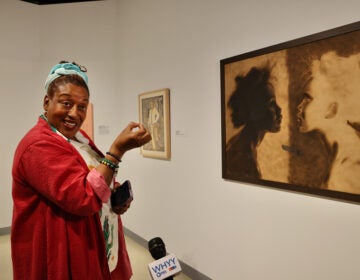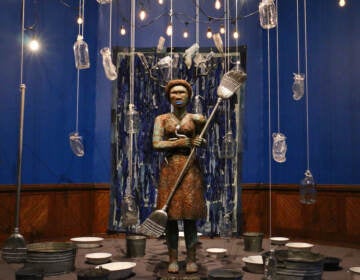Philly native writes first biography of collagist Romare Bearden, 30 years after his death
The life of artist Romare Bearden, best known for his collage work, is chronicled by Philadelphia native Mary Schmidt Campbell.
Listen 2:13
A collage piece, "Captivity and Resistance," by Romare Bearden, commissioned by the African American Museum in Philadelphia in 1976.
The African American Museum in Philadelphia on Thursday is hosting the author of a new biography of Romare Bearden, a major black artist best known for his collage work in the 1960s and 70s. He died in 1988.
“An American Odyssey: the Life and Work of Romare Bearden” by Mary Schmidt Campbell is the first book-length biography about him.
Campbell grew up in Philadelphia, attended Philadelphia High School for Girls and Swarthmore College. She left to attend graduate school at Syracuse University where she first met Bearden in 1970, when she organized a campus exhibition of his work.
Later, Bearden would advise her to pursue the director position at the fledgling Studio Museum in Harlem, then a small neighborhood gallery in a loft space. During her tenure, in 1982, it moved into a new 60,000-square-foot building (currently closed for reconstruction) and became a premiere showcase of African-American art.
She went on to run New York City’s Department of Cultural Affairs, and acted as dean of New York University’s Tisch art school. Currently, she is president of Spellman College, an historically black college for women in Atlanta, Georgia.
As she moved through her long career in arts administration, Campbell, now 71, continued to write articles about Bearden, getting closer to the artist she has admired for almost 50 years.
“I said to myself, if I could ever piece the time together – I have three children and six grandchildren – I would love to write a book on Romare Bearden,” she said.
As America’s foremost collage artist and an important African-American presence in the fine art world, much has been written about Bearden, but until now, no one has attempted to tell the story of his life.
Bearden was from Pittsburgh and emerged as an artist in Harlem in the 1930s, where he also worked for decades as a full-time case worker for the New York Department of Social Services.
“The reality did not hit me until I wrote the book,” said Campbell, “how onerous it was to have this full-time job during his lifetime, and still being able to produce a coherent and ground-breaking body of work.”
Bearden served in Europe during World War II, then came back to New York and was assigned to work with the Romani community.
“To understand somebody else, somebody’s else’s priorities in life, and crawl around in their skin – that quality is something of his day job,” said Campbell. “That informed his art. He probably wouldn’t have said that when he was alive, but I think it’s true.”
Bearden was a founding member of an artist collective called Spiral, which considered the role of the artist during the Civil Rights movement. He also wrote jazz music, including “Sea Breeze,” a song picked up by Dizzy Gillespie.
In digging into Bearden’s life, Campbell writes that at first, he wanted to shed the moniker of what was, at the time, the “Negro” artist. He wanted to be known simply as an artist, without the racial qualifier. His work in collage is second to none.
As he progressed through his career and developed his work, he eventually circled back to embrace his heritage.
“When he came to make collages, he began to see that his race, his history, his heritage was this incredible inheritance. He was heir to an extraordinary tradition in music, in literature, in folklore, and visual culture that he could draw on,” said Campbell. “He said at one point, ‘I’m a whale: I open my mouth and take in everything that belongs to me.’”
Bearden was once commissioned to make a collage for the African American Museum in Philadelphia for its opening in 1976. That’s where Campbell will be reading from her new book on Thursday evening.
WHYY is your source for fact-based, in-depth journalism and information. As a nonprofit organization, we rely on financial support from readers like you. Please give today.





